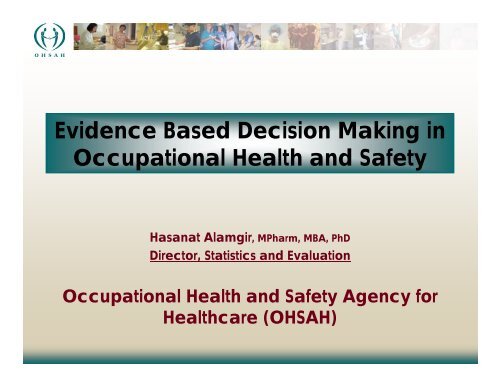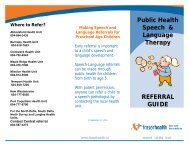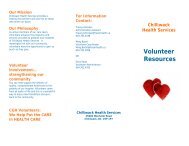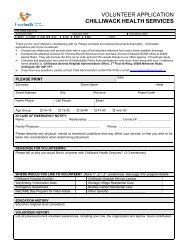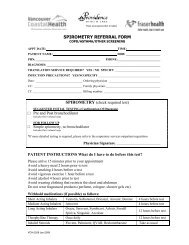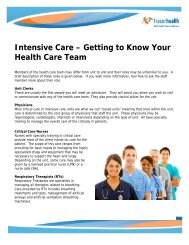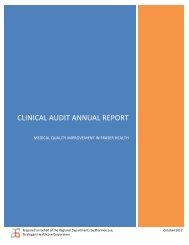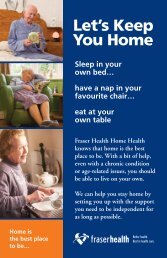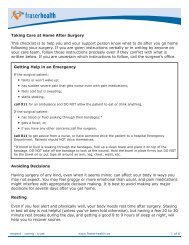Evidence Based Decision Making in Occupational Health and Safety
Evidence Based Decision Making in Occupational Health and Safety
Evidence Based Decision Making in Occupational Health and Safety
Create successful ePaper yourself
Turn your PDF publications into a flip-book with our unique Google optimized e-Paper software.
Presentation Outl<strong>in</strong>e<strong>Health</strong> care sector statistics-WorkSafeBCOHSAH• M<strong>and</strong>ate• WHITE TM database• An Example-Ceil<strong>in</strong>g Lift research <strong>in</strong> VCH
OHSAH’s formation• <strong>Health</strong>care system difficulties• Concern about musculoskeletal <strong>in</strong>juries, <strong>in</strong>fectiousdiseases, chemical-<strong>in</strong>duced disorders, violence,stress• High rates of <strong>in</strong>jury/illness among staff• Escalat<strong>in</strong>g compensation costs, loss of productivity• Impact on quality of care• Changes <strong>in</strong> the nature of care provided, shifts <strong>in</strong>work patterns• Change <strong>in</strong> profile of patients/residents• Staff issues- ag<strong>in</strong>g, shortage
Statistics on <strong>Health</strong> <strong>and</strong> <strong>Safety</strong> <strong>in</strong> <strong>Health</strong> Care
Injury Rate by Sector1098Injury 7Rate/100 6personyears54321General ConstructionTransportationAll Sectors<strong>Health</strong> Care <strong>and</strong> Social AssistanceForestry02001 2002 2003 2004 2005 2006Year<strong>Health</strong>care only claims excluded(WorkSafeBC)
2006 StatisticsNumber of ClaimsDays lost from WorkClaims CostsGeneral Construction19,062359,476108,714,808<strong>Health</strong> Care <strong>and</strong> Social Assistance12,419297,49152,397,554Transportation8,806246,11366,785,305Wood <strong>and</strong> Paper Products9,826137,97965,508,397Forestry2,56090,43357,047,503Other sectors78,4451,809,629496,681,965Total131,1182,941,121847,135,532• Days lost from work: for current year <strong>and</strong> prior years’ <strong>in</strong>juries; 56% current year• Number <strong>and</strong> costs of claims: <strong>Health</strong> care only+ short term disability+ long term disability + fatal)(WorkSafeBC)
Injury rate by Sub-sectorIn ju ry rate2520151050Acute Care Community <strong>Health</strong> Support Services Long Term Care11.28.28.48.1105.46.33.94.544.95.14 3.84.12001 2002 2003 2004 2005Year(WorkSafeBC)
Type of Injury: 2006Harmful substances9%Miscelleaneous6%Transportation1%Struck by/aga<strong>in</strong>st anobject10%Rubbed or abraded0%Falls14%Caught In1%Overexertion, bodilymotion59%(WorkSafeBC)
Workplace Heath Indicator Track<strong>in</strong>g <strong>and</strong>Evaluation (WHITE) DatabaseWeb-based system, facilitat<strong>in</strong>g analysis of <strong>in</strong>cidents,<strong>in</strong>juries, risk factors <strong>and</strong> prevention/ follow up measures
Comprehensive WHITE Modules• Incident Investigation – collection of <strong>in</strong>cidentdetails• Secondary Injury Prevention <strong>and</strong> CaseManagement• Employee <strong>Health</strong> - TB status, immunizations, etc.• <strong>Health</strong> <strong>and</strong> <strong>Safety</strong> - records of tra<strong>in</strong><strong>in</strong>g, exposureassessments, control measures, respirator fit test<strong>in</strong>g.• Extensive analytical features – multidimensionalanalysis (i.e. data cubes)
Incident Investigation
Use of WHITE• Injury reports periodically to <strong>Health</strong> Authority• Effectiveness/Cost-benefit analyses of <strong>in</strong>terventions• Ceil<strong>in</strong>g lifts• PEARS• Focused analyses on specific <strong>in</strong>jury type (MSI, BBF…)<strong>and</strong> occupations (RN, LPN, Care Aides…)• Answer Research Questions, like• Is there any difference of <strong>in</strong>jury risk by gender or jobstatus (full-time, part-time <strong>and</strong> casual workers)?
Ceil<strong>in</strong>g Lift Research
Rationale <strong>and</strong> Background• Patient h<strong>and</strong>l<strong>in</strong>g tasks are physically dem<strong>and</strong><strong>in</strong>g, performedunder unfavorable conditions, <strong>and</strong> unpredictable <strong>in</strong> nature.• Patient factors complicate tasks -variations <strong>in</strong> size, functionalstatus, cognitive function<strong>in</strong>g, cooperation, fluctuations <strong>in</strong>condition <strong>and</strong> fatigue• Many patient lifts done <strong>in</strong> awkward positions-bend<strong>in</strong>g overbeds/chairs• Inadequate space <strong>and</strong> poorly designed work environmentscontribute to awkward positions• The average weight of an adult male patient is currently 185 pounds• The cumulative weight lifted by a nurse <strong>in</strong> one typical 8-hour shift is 1.8 tons
Patient care <strong>and</strong> health of StaffStaff Injury short staff<strong>in</strong>g workloadImpact on patient care
Rationale <strong>and</strong> Background• Several studies demonstrate safe patient lift<strong>in</strong>gdevices can reduce frequency, severity, <strong>and</strong> cost ofcaregiver <strong>in</strong>juries• There is no evidence l<strong>in</strong>k<strong>in</strong>g these programs toquality of care• Improvements <strong>in</strong> quality of care are noticed , but largely anecdotal• If these <strong>in</strong>terventions have a direct impact on patientcare --enhance organizational support of these
Rationale <strong>and</strong> BackgroundLift<strong>in</strong>g devices are said to <strong>in</strong>crease the frequency <strong>and</strong> ease of mov<strong>in</strong>g a patient<strong>and</strong> improve quality of lifePossible outcome measures, <strong>in</strong>clude• cognitive function<strong>in</strong>g depression <strong>and</strong> anxiety,• physical function<strong>in</strong>g toilet<strong>in</strong>g outcomes• sk<strong>in</strong> <strong>in</strong>tegrity decrease <strong>in</strong> combativeness• Improved behavior reduction <strong>in</strong> falls• Less <strong>in</strong>cidents of RTI <strong>and</strong> UTIMore mobile <strong>and</strong> better function<strong>in</strong>g patients are more likely to• <strong>in</strong>crease their level of activity,• decrease healthcare utilization,• <strong>in</strong>crease their discharge potential,• <strong>in</strong>crease participation <strong>in</strong> therapy,• <strong>and</strong> their health status may improve
IndirectThe ConnectionDirectDirect
The ObjectivesVancouver Coastal <strong>Health</strong>• Undertake systematic<strong>in</strong>vestigation of the worth ofoverhead mechanical lifts• Work as template for futuresimilar OH&S <strong>in</strong>terventions
1) Observational study (tim<strong>in</strong>g <strong>and</strong> frequency ofceil<strong>in</strong>g lift use)2) Objective Patient outcome3) Patient Perception4) Staff Perception5) Cost-benefit AnalysesStudy components
I-Observational StudyQuestions:1) Does the use of a CL decrease time of patient transfer <strong>and</strong>number of staff required when compared to other patienth<strong>and</strong>l<strong>in</strong>g methods?2) What is the frequency of CL usage compared to other patienth<strong>and</strong>l<strong>in</strong>g devices?3) Are patients <strong>in</strong> facilities with CL transferred more frequentlycompared to those without?Study Design:Cross sectional study, facilities with <strong>and</strong> without ceil<strong>in</strong>g lifts
II-Objective Patient OutcomeQuestions:Does the use of a CL improve patient outcome <strong>in</strong>dicators?Study Design:Pre/post-<strong>in</strong>tervention <strong>and</strong> Cross sectional study us<strong>in</strong>g st<strong>and</strong>arddatabasesPatient Outcome Measures:<strong>in</strong>cidents of falls; <strong>in</strong>cidents of pressure ulcers; RTI?,UTI?, Wounds?Data Sources:QUIST database, Wescom
III – Patient PerceptionQuestions:Does the use of CL improve patients’ perceptions ofsafety, pa<strong>in</strong>, comfort <strong>and</strong> overall satisfaction dur<strong>in</strong>gtransfers?Design:Cross sectional study by us<strong>in</strong>g questionnaires/FocusGroup <strong>in</strong> acute care facilities
IV-Staff PerceptionQuestion:Does the use of CL improve staff’s perceptions of pa<strong>in</strong>, safety,comfort <strong>and</strong> overall satisfaction dur<strong>in</strong>g transfers?What are the key barriers <strong>and</strong> facilitators <strong>in</strong> optimal use of ceil<strong>in</strong>glift?Design:Questionnaire/Focus Group us<strong>in</strong>g control groups <strong>in</strong> acute &extended careOutcome Measures: Ease of use, availability, accessibility,versatility, storage; policy & procedures, tra<strong>in</strong><strong>in</strong>g, safety culture
V-Cost Benefit AnalysisQuestions:Is it effective <strong>in</strong> reduc<strong>in</strong>g number of Patient h<strong>and</strong>l<strong>in</strong>g related MSIclaims, claims costs <strong>and</strong> time-loss?What is the payback period <strong>and</strong> return on <strong>in</strong>vestment?Design:Pre- <strong>and</strong> post- <strong>in</strong>tervention MSI claims <strong>and</strong> claim costsCross sectional <strong>and</strong> with control group
Challenges• Literature on patient outcome• Data sources• Control group• Pre-post trend• Data availability• Attribution• Indirect costs• Difficulty <strong>in</strong> study<strong>in</strong>g LTC residents
Recent publicationsAlamgir H, Cvitkovich Y, Yu S, Yassi A.. Work-related <strong>in</strong>jury among Direct Care occupations <strong>in</strong> British Columbia,Canada.Occup Environ Med. 2007 May 23Alamgir H, Sw<strong>in</strong>kels H, Yu S, Yassi A. <strong>Occupational</strong> <strong>in</strong>jury among cooks <strong>and</strong> food service workers <strong>in</strong> the healthcaresector.Am J Ind Med. 2007 Jun 7Alamgir H, Cvitkovich Y, Yu S, Astrakianakis G, Yassi A.. Needlestick <strong>and</strong> other potential blood <strong>and</strong> body fluid (BBF)exposures among healthcare workers <strong>in</strong> British Columbia, Canada.American Journal of Infection Control ( In Press)Badii M, Keen D, Yu S, Yassi A. Evaluation of a comprehensive <strong>in</strong>tegrated workplace-based program to reduceoccupational musculoskeletal <strong>in</strong>jury <strong>and</strong> its associated morbidity <strong>in</strong> a large hospital.J Occup Environ Med. 2006 Nov;48(11):1159-65.Miller A, Engst C, Tate RB, Yassi A. Evaluation of the effectiveness of portable ceil<strong>in</strong>g lifts <strong>in</strong> a new long-term carefacility.Appl Ergon. 2006 May;37(3):377-85. Epub 2005 Dec 27.


